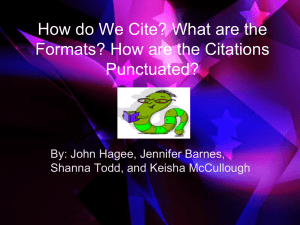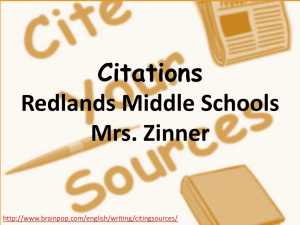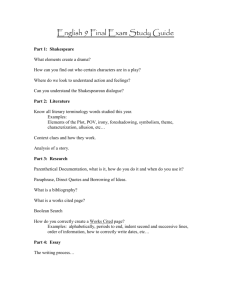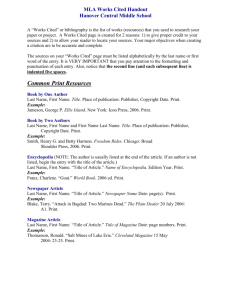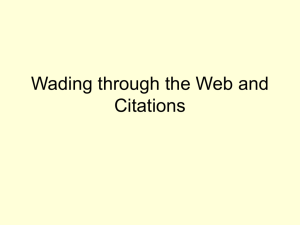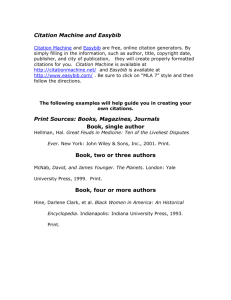Sample Bibliographic Citations
advertisement
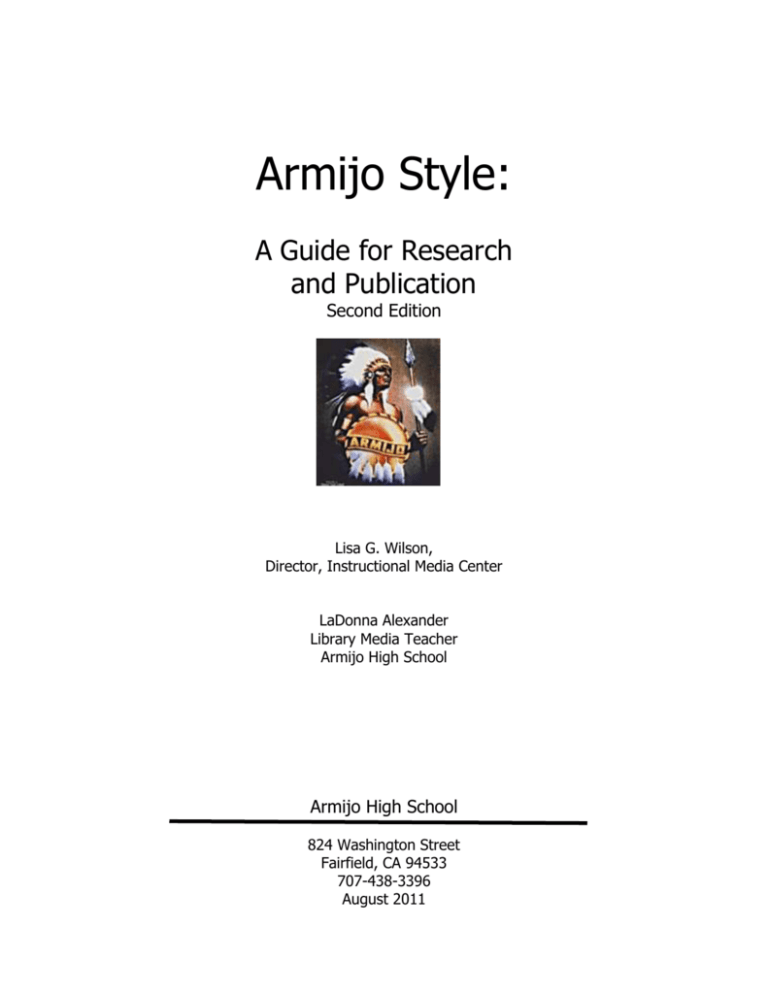
Armijo Style: A Guide for Research and Publication Second Edition Lisa G. Wilson, Director, Instructional Media Center LaDonna Alexander Library Media Teacher Armijo High School Armijo High School 824 Washington Street Fairfield, CA 94533 707-438-3396 August 2011 Page 2 Table of Contents Sample Bibliographic Citations 3 General rules .........................................................................................................3 Annotated Bibliography ..........................................................................................3 Citation Machine ....................................................................................................3 Print Sources: Books, Magazines, Journals ..............................................................4 Book, single author ............................................................................................4 Book, two or three authors .................................................................................4 Book, four or more authors .................................................................................4 Book by corporate author or group ......................................................................4 Encyclopedia article, no author ............................................................................4 Encyclopedia article with author ..........................................................................4 Magazines and Newspapers (in print) ..................................................................5 Online Resources: Subscription Databases and Websites ..........................................5 Online Databases (InfoTrac, EBSCO, etc.) ............................................................5 Internet Sites (not subscription databases) ..........................................................7 Parenthetical Documentation…………………………………………………………. …….7 General Rules.....................................................................................................7 Placing a Parenthetical Reference ........................................................................8 Documenting a Direct Quotation .........................................................................8 Documenting a Paraphrase or Summary ..............................................................8 Research Paper Format…………………………………………………………………………8 Typing and Printing ...............................................................................................8 Heading ................................................................................................................8 Sample Research Paper, first page ..........................................................................9 Sample Works Cited Page ......................................................................................9 Sample “Works Cited” page ....................................................................................9 Plagiarism……………………………………………………………………………………...10 Evaluating Information…………………………………………………………………………10 Reliability: Authority and Authorship ..................................................................... 10 Currency ............................................................................................................. 11 Motivation ........................................................................................................... 11 Opinion and Point of View .................................................................................... 11 Accuracy ............................................................................................................. 11 Coverage ............................................................................................................ 11 Final Analysis....................................................................................................... 11 Page 3 Sample Bibliographic Citations General rules 1. Give the author’s name exactly as it appears on the title page, but list the last name first. Put a period after the complete name. Walker, Alice. 2. Provide the full title of the book, including any subtitle in italics. If the book has a subtitle, put a colon directly after the main title. Place a period at the end of the title. Back of Beyond: Stories of the Supernatural. 3. Provide the following publication information in this order: Edition. city of publication, publisher’s name, and year of publication (copyright date). All of this information can be found on the title page or the copyright page, which is generally found on the back of the title page. Place a period after the edition, a colon after the city, a comma after the publisher, and a period at the end. For printed materials, add Print followed by a period at the end. 2nd. New York: Scribner, 2006. Print. 4. The entire citation should be double spaced with the first line at the left margin and all other lines indented (hanging indent). 5. Alphabetize the list by the first word in the citation. Annotated Bibliography An annotated bibliography or works cited page includes not only the full citation, but also some information about the content of the book, article, or website. For example: Bates, J.D. Writing with Precision: How to Write So That You Cannot Possibly be Misunderstood. New York: Penguin Books, 2001. Print. Discusses the principles of clear, effective writing; offers help on preparing and writing specific kinds of material, such as letters, memoranda, and reports. Citation Machine and Easybib Citation Machine and Easybib are free, online citation generators. By simply filling in the information, such as author, title, copyright date, publisher, and city of publication, they will create properly formatted citations for you. Citation Machine is available at http://citationmachine.net/ and Easybib is available at http://www.easybib.com/ . Be sure to click on “MLA 7” style and then follow the directions. Page 4 The following examples will help guide you in creating your own citations. Print Sources: Books, Magazines, Journals Book, single author Hellman, Hal. Great Feuds in Medicine: Ten of the Liveliest Disputes Ever. New York: John Wiley & Sons, Inc., 2001. Print. Book, two or three authors McNab, David, and James Younger. The Planets. London: Yale University Press, 1999. Print. Book, four or more authors Hine, Darlene Clark, et al. Black Women in America: An Historical Encyclopedia. Indianapolis: Indiana University Press, 1993. Print. Book by corporate author or group American Medical Association. American Medical Association Handbook of First Aid and Emergency Care. New York: Random House, 2005. Print Encyclopedia article, no author Place quotation marks around the article title and underline the encyclopedia title. When citing a very familiar encyclopedia, like World Book, do not give the full publication information. You only need to include the year published and the edition number, if provided. “Dinosaur.” World Book Encyclopedia. 7th . 2007. Print Encyclopedia article with author Peterson, Barbara Bennett. “Rita Hayworth.” The Scribner Encyclopedia of American Lives. 3rd. New York: Charles Scribner’s Sons, 1999. Print Page 5 Magazines and Newspapers (in print) General Rules 1. Give the author’s name just as you do for books. 2. The title of the article is placed in quotation marks with a period at the end of the title. 3. The magazine title is underlined followed by the date. 4. Provide the complete date beginning with the day and abbreviating the month, followed by a colon and the page numbers of the article. Magazine Article: Beschloss, Michael. “The Ford Effect.” Newsweek 8 Jan 2007: 30-33. Print Newspaper Article: Farmer, Paul. “A Family Affair.” Daily Republic 19 Dec 2006: D1. Print Online Resources: Subscription Databases and Websites Online Databases (InfoTrac, EBSCO, etc.) General Rules 1. These citations work very much like print citations. Most of the articles you will find in InfoTrac and EBSCO are simply reproduced from print resources and placed online. 2. You must include the article title in quotes, the title of the database underlined, the date the article was published (if available), and the date you accessed the information The web address (url), is optional. Examples From InfoTrac Biography Resource: “A. A. Milne.” Contemporary Authors Online. 2007. Reproduced in Biography Resource Center. Web. 5 Jan 2007 <http://galenet.galegroup.com/servlet/BioRC>. From World Book Online: Hartman, John. "Argentina." World Book Online Reference Center. 2007. Web. 12 Feb 2007 <http://www.worldbookonline.com/wb/Article?id=ar595380>. From EBSCO: Page 6 “Anorexia, Bullimia Prove Gene Related.” USA Today Magazine Oct 2006. EBSCOHost Student Research Center. 26 Jan 2006 Web. http://search.ebscohost.com/ login.aspx?direct=true&db=ulh&AN=22604962&site=src-live Page 7 Internet Sites (not subscription databases) General Rules: 1. To cite a webpage, at the minimum you must include the title, the web address (url), and the date you accessed the page. 2. If you can also find any of the following information, then include it in your citation: web article title, author, name of sponsoring organization or company, and the date the web page was last updated. Examples: "Diabetes Information." U.S. Food and Drug Administration. 2002. Department of Health and Human Services. Web. 19 Jan 2007 <http://www.fda.gov/diabetes/>. “Taking Part in the Active Lifestyle Program.” The President’s Challenge 25 Mar 2007. Web. <http://www.presidentschallenge.org/the_challenge/active_lifestyle.aspx>. Parenthetical Documentation The term “parenthetical documentation” sounds much more complicated than it is. This style allows your reader to easily recognize the experts or authorities cited in the paper. According to Write It: A Guide for Research, “sources used in research are documented in two ways. First, a parenthetical note acknowledges the source of information within the text of the paper. Second, a complete citation is listed on the final page of a research paper under the title “Works Cited” or “Bibliography” (Bankhead, Nichols and Vaughn 17). The whole point of citing sources is to allow the reader to quickly and easily locate the original source of information. General Rules 1. The parenthetical reference contains the author’s last name and the page number where the material can be found. For example: (Taylor 128) 2. The parenthetical reference comes before the punctuation mark that ends the sentence, clause, or phrase containing the quoted or paraphrased material. Page 8 3. If the author is referred to in the sentence, you do not need to repeat the author’s name in the parenthetical reference. For example: According to Encalada, long distance runners are the most fit of all athletes (38). 4. If the quotation is long—taking up more than four lines of your paper—set the quotation off from the rest of the paper by beginning a new line and indenting the whole quote one inch from the left margin. For these long quotes, double space but do not use quotation marks. Placing a Parenthetical Reference To keep your writing flowing smoothly, place the parenthetical reference at the first natural pause in the sentence. Often this is at the end of the sentence, but it might also be placed at the end of a clause or phrase containing the cited material. For example: “It was the best of times, it was the worst of times,” Charles Dickens wrote of the eighteenth century (22). The following examples will help you format your paper. Documenting a Direct Quotation “Many teenage boys now drink five or more cans of soda a day. Each can contains the equivalent of about ten teaspoons of sugar” (Schlosser and Wilson 143). Documenting a Paraphrase or Summary Contrary to commonly held beliefs, the people of the American colonies had an advanced understanding of the technology of farming, surveying land, and building construction (Burns). Research Paper Format Typing and Printing Choose Times New Roman font with a type size of 12 point. Print on one side of the paper only. Justify the lines of your paper at the left margin Double-space the entire paper, including the heading, quotations, and the list of works cited. Indent the first word of a paragraph one-half inch or five spaces. All margins (top, bottom, left, and right) should be one inch. Heading The heading should be placed in the upper left corner and must include the following information, all on separate lines, with a double-space between the lines: o Your name o Your teacher’s name o Class name o Date Page 9 Sample Research Paper, first page Johnny B. Good Mrs. Adams American Government January 16, 2012 Free Speech in Public Schools The United States Supreme Court has addressed the issue of free speech in America’s public schools on numerous occasions. Perhaps the most well known Sample Works Cited Page Sample “Works Cited” page Works Cited Hellman, Hal. Great Feuds in Medicine: Ten of the Liveliest Disputes Ever. New York: John Wiley & Sons, Inc., 2001. Print. Hine, Darlene Clark, et al. Black Women in America: An Historical Encyclopedia. Indianapolis: Indiana University Press, 1993. Print. Page 10 Plagiarism According to the MLA Handbook for Writers of Research Papers: The purpose of a research paper is to synthesize previous research and scholarship with your ideas on the subject. Therefore, you should feel free to use other persons’ words, facts, and thoughts in your research paper, but the material you borrow must not be presented as if it were your own creation. When you write your research paper, remember that you must document everything that you borrow—not only direct quotations and paraphrases but also information and ideas. (Gibaldi 69) Any of the following would constitute plagiarism: Submitting another writer’s paper as your own Copying a part of another writer’s paper and incorporating it into your paper Quoting a source word for word without using quotation marks and a citation Paraphrasing and/or summarizing another’s ideas without giving a citation “Cutting and pasting” from electronic sources without crediting the source (Giles and Richards 16). Public Domain Some information is commonly known by many, many people and is accepted as common knowledge or public domain. This kind of information does not need to be cited. For example, every high school student knows that George Washington was the first President of the United States. You would not need to cite that fact in a paper. However, if you include in your paper that the electors of the Federal Convention unanimously elected him President, you must cite your source. Plagiarism is the theft of the ideas or intellectual property of another and is therefore a very serious offense. Be very careful to give credit in your paper to all information, ideas, and concepts that are not your own. Evaluating Information An information literature person knows how to access, evaluate and use information. How do you decide if information is accurate? A great starting place for reliable information is our Armijo High School Library. All of the books at the Armijo library were picked by a professional librarian to support our students. Likewise, the online databases and Internet pathfinders on our webpage have also been evaluated for quality and reliability. The following are some things to consider when evaluating websites (Irwin): Reliability: Authority and Authorship 1. Who is the author? 2. Have you heard of this author before? Page 11 3. What are the author’s credentials and/or education? 4. What is the sponsoring institution or organization? 5. Have you heard of this institution before? Currency 1. When was the page first published? 2. When was it last updated? 3. Does the date matter? If you are researching Shakespeare, it probably doesn’t matter that the webpage is five years old. However, if you are looking for new cancer treatments, then five years is far too outdated to be useful. Motivation 1. Is the author’s motivation in making the page stated or unstated? 2. How does the author describe his or her motivation? 3. Why do you think the author created this page? Opinion and Point of View 1. 2. 3. 4. What point of view is expressed in this site? How does the opinion affect the trustworthiness of the information? Does the opinion invalidate the argument being made? What information might have been left out because of the author’s opinion? Accuracy 1. Does the page present consistent information? 2. Has the author edited the page for spelling and grammar? Coverage 1. Is this page: Scholarly or academic? Popular? A Joke? Written by a lunatic? 2. Does the information seem complete? Why or why not? 3. What, if anything is left unmentioned or ignored? Final Analysis Do you think your teacher would want you to use this page? Why or why not? Works Cited Bankhead, Betty, Janet Nichols and Dawn Vaughn. Write It: A Guide for Research. Englewood, CO: Libraries Unlimited, 1999. Print Gibaldi, Joseph. MLA Handbook for Writers of Research Papers, 7th ed. New York: The Modern Language Association of America, 2009. Print. Page 12 Giles, Beth, and Ann Richards. In Grand Style: A Guide for Research, 4th ed. Available at Grandview High School, 20500 E. Arapahoe Road, Aurora, CO. Print. Irwin, Ken. Criteria for Website Evaluation. University of Michigan Shapiro Undergraduate Library, Web. 25 Jan 2007 < http://www.lib.umich.edu/ugl/guides/evaluation/>.
